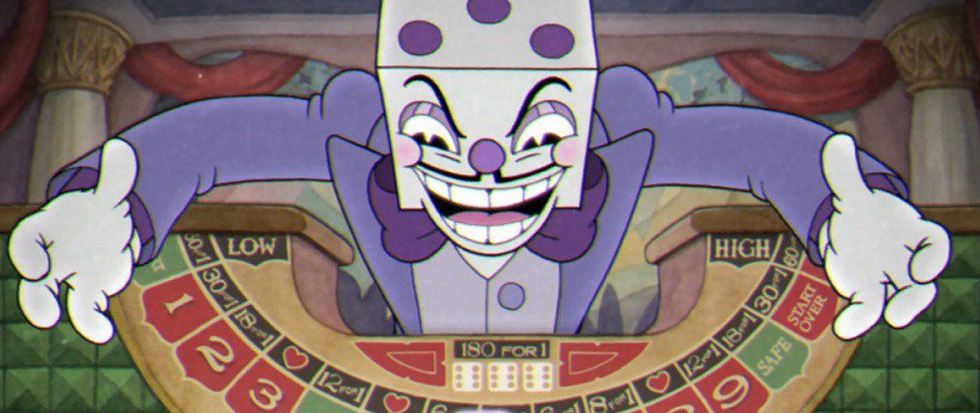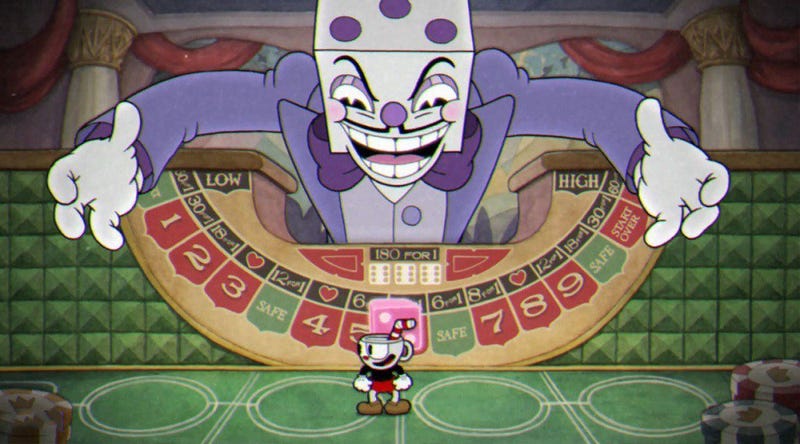Cuphead and the Racist Spectre of Fleischer Art | Unwinnable
Cuphead and the Racist Spectre of Fleischer Animation
By
Yussef Cole • November 10th, 2017
Cuphead is a 2D platformer with run-and-gun gameplay reminiscent of classic games like Mega Man. What sets
Cuphead apart from its predecessors is its unique aesthetic which pays stunning homage to early 20th century American animation. The artists at Studio MDHR, the Canadian company which developed the game, have done an impressive job recreating the dynamic rubber-hose character animation that producers like the Fleischers and Walt Disney made famous in the 1930s. By setting their game in this aesthetic, however, Studio MDHR also dredge up the bigotry and prejudice which had a strong influence on early animation.
When asked in a
Rolling Stone interview about the unfortunate associations of
Cuphead‘s 1930s aesthetic, lead inking artist for the game, Maja Moldenhauer replies: “It’s just visuals and that’s about it. Anything else happening in that era we’re not versed in it.” But these visuals are weighed down by the history that brought them into being, despite the developers best efforts at stripping them of the more overt caricatures that are rife in cartoons for most of the first half of the 20th century. By sanitizing its source material and presenting only the ostensibly inoffensive bits, Studio MDHR ignores the context and history of the aesthetic it so faithfully replicates. Playing as a black person, ever aware of the way we have historically been, and continue to be, depicted in all kinds of media, I don’t quite have that luxury. Instead, I see a game that’s haunted by ghosts; not those confined to its macabre boss fights, but the specter of black culture, appropriated first by the minstrel set then by the Fleischers, Disney and others -twisted into the caricatures that have helped define American cartoons for the better part of a century.
One of the first artists to make a name for himself with animation, James Stuart Blackton, would often animate in real time during vaudeville shows. In 1907 he produced his “
Lightning-Sketches,” which involved converting the written word “c00n” into a minstrel caricature and “Cohen” into an anti-semitic stereotype. Vaudeville theater, which evolved out of the remnants of minstrel shows, often employed stereotypes and racist caricatures such as these for comedic effect. Many animators frequented vaudeville theaters after work, and were inspired by its methods.
The truth is racist stereotypes make for easy laughs (ask any faux-edgy comedian). And animation has always been a comedy-centric medium. In his book,
Birth of an Industry, Nicholas Sammond writes:
“The stereotypical depiction… borrowing both from well-established graphic traditions and from minstrelsy, variety shows and vaudeville, also traded on an economy of efficiency in which characters immediately telegraphed their seemingly inherent natures and from that their place in the gag.”
Many early cartoon characters were tricksters, layabouts, and thieves, archetypes born from the depiction of the lazy slaves minstrel shows specialized in.
Cuphead happens to star a pair of tricksters, Cuphead and Mugman, who make a deal with the devil over a gambling debt, an activity often linked in 1930s cartoons to the implied sinfulness and savagery of black Harlem and the era of swing music and jazz.
1930s Harlem and the jazz culture centered within it are a major part of
Cuphead’s aesthetic, from its big band soundtrack to the design of characters like King Dice whose pencil thin mustache recalls the iconic look of Cab Calloway -himself a major player in early cartoons both as a cameo and as a caricature. Jazz culture tended to have a fraught relationship with the animation industry. According to Sammond: “…the jazz caricature of the early sound years seemed to pay homage to an imagined libidinous freedom of swing music and culture and to immediately offer up guilty punishment for taking pleasure in its apparent excesses.”
For example, Jay Z recently released a
music video called
The Story of O.J. in which he and the rest of the cast are animated in explicitly racist caricature, with big pale lips eclipsing dark faces. The video uses this striking visual imagery to accompany a song about the realities of being black in a world that still sees you as a stereotype (which makes Jay-Z’s own gross anti-Semitic stereotypes that much worse). Here, the caricature has a purpose, which is to remind us of our history; to proclaim that it isn’t behind us, and that we can’t, as O.J. tried, truly ever shed our skin color.
Similarly, the artist Kara Walker, uses a cutout style to create giant tableaus featuring mammies, sambos and other black caricatures to engage in the “…the meaty, unresolved, mucky blood lust of talking about race…” as she tells Vulture in an
interview. What is made evident by her art, is that race is not a solved matter, not a period in our past that we, as a society, can claim to have solved. Most black Americans cannot help but recognize this depressing fact, and the events of the past year have made it hard for anyone but hardcore bigots to ignore.
The images in Walker’s work and in
The Story of O.J. are meant to provoke, to pick at a wound that has never truly healed. But
Cuphead is just supposed to be a fun game; and it is -beautiful too. Yet playing it brings along that particular queasiness one gets when being forced to ignore problematic parts of media in order to enjoy it. After all, it’s difficult to enjoy the same images that brought down houses I would never have been allowed to enter. It’s hard to overlook a style that was also used to belittle and stigmatize blackness to the extent that we are still fighting to regain our own image. As Samantha Blackmon writes in her
excellent piece on the subject: “My life, my experiences, and the body that I live in makes
Cuphead and its artistic style problematic to me because of all that it has come to mean in the last 85 years or so…”
It’s a mistake to whitewash history, not if we hope to improve upon the present. After all, the animation industry is still so white that a
roundtable about diversity last year had only white men on it. The videogame industry is
no better. It’s difficult to argue against the idea that this lack of diversity winds up having a strong effect on the kinds of stories that get told, and the sort of aesthetics and time periods studios feel comfortable borrowing from in the first place.
After World War II, when the NAACP and other organizations ran campaigns criticizing explicitly racist caricatures in animation, the industry responded by simply ceasing to create black characters of any kind. In Christopher P. Lehman’s
The Colored Cartoon he writes: “No theatrical cartoon studio created an alternative black image to the servile, crude, hyperactive clowns of the preceding half-century. The cartoon directors of the 1950s, many with animation careers dating back to the 1920s, had no experience in developing such a figure.” Studio MDHR, in interviews, is quick to point out that they avoided stereotypes in
Cuphead; that they
focused on “the technical, artistic merit, while leaving all the garbage behind.” The truth may be dirty, and often uncomfortable. But it’s preferable to offering up a bleached white past, while pretending nothing was lost in the process.














